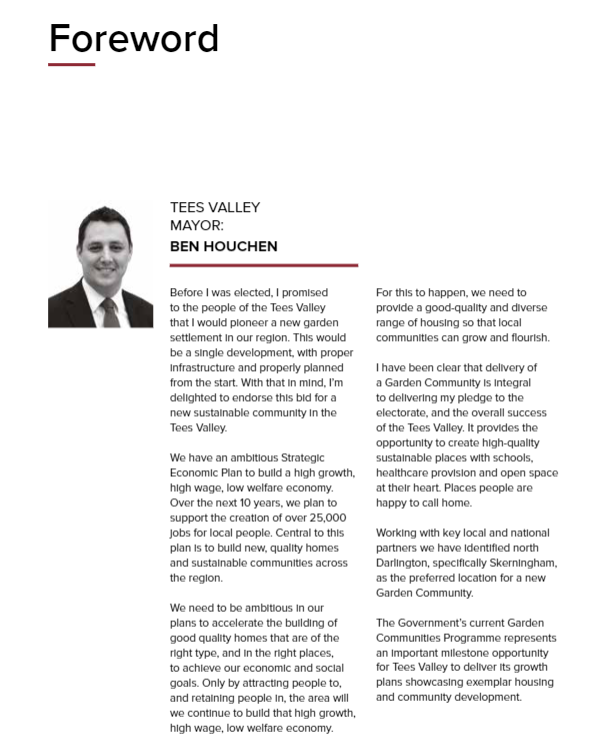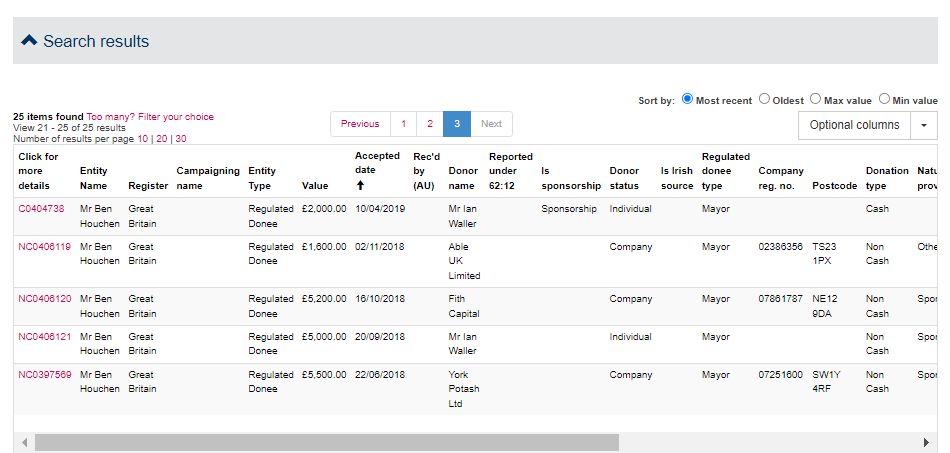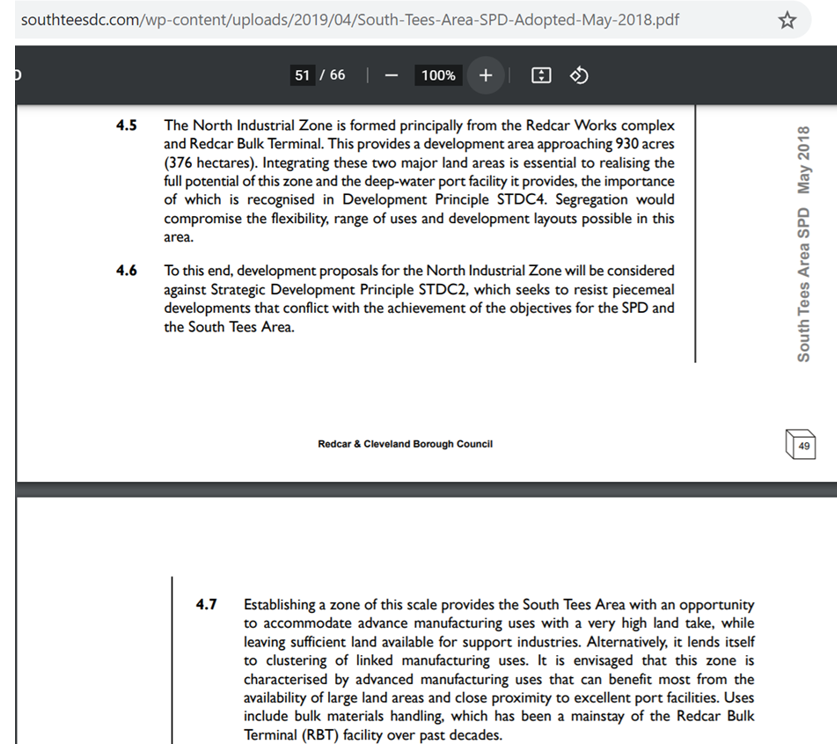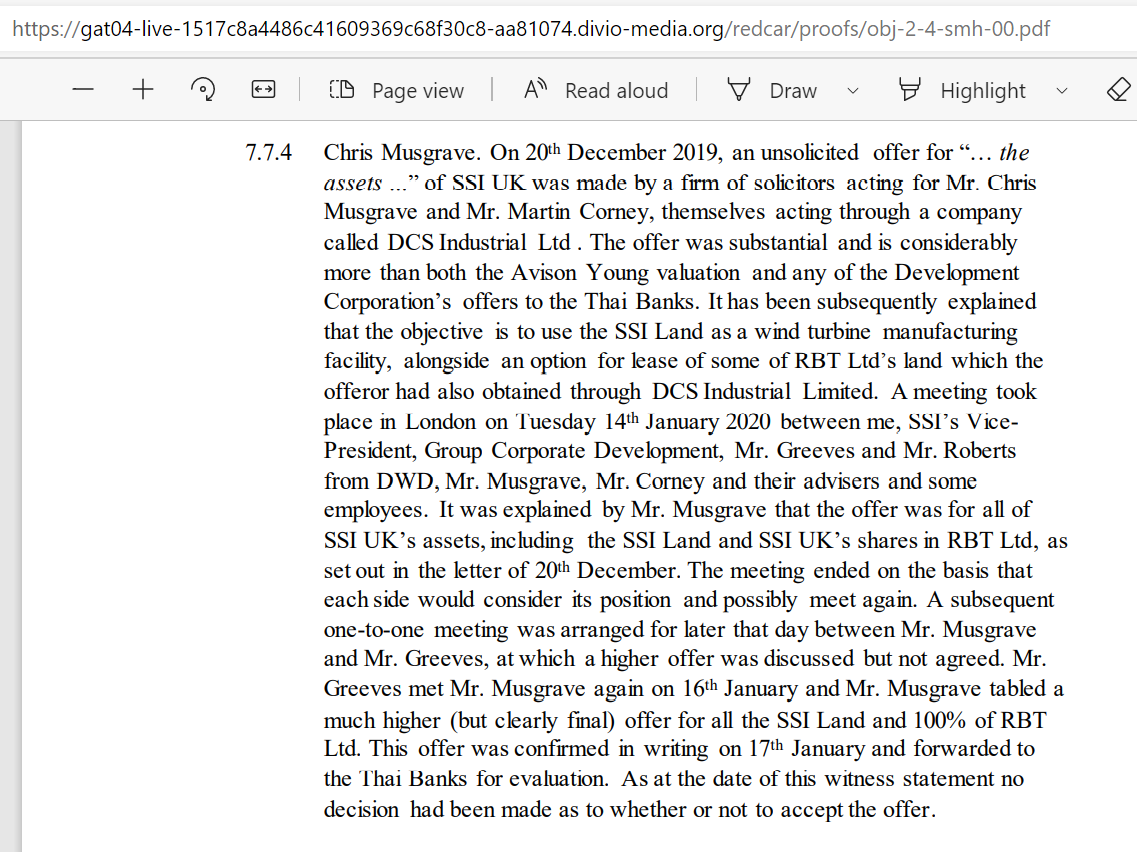12 August 2019:
The Day the
Teesworks
Corruption
Scandal Began
in Earnest

Scott Hunter
28 January 2024
Tees Valley mayor, Ben Houchen, has been under investigation for corruption for several months now, and the report into that is due imminently. There are a number of reasons why we expect to be disappointed by it. One is that the inquiry process was commissioned by Michael Gove, who is a cheerleader for Houchen, and so there is the suspicion that the most incriminating evidence will not see the light of day. A second concerns the narrow scope of the inquiry, whereby the TVCA involvement in the management of Teesside Airport is excluded, and only the situation at Teesworks is at issue. Finally, there is the possibility that the significance of some key events may be underestimated. One of these concerns what took place around 12 August 2019 and what proceeded from it.
A Timeline of Events
In January 2020, the developers, Martin Corney and Chris Musgrave had no involvement either in Teesside Airport or STDC. By April of that year, they had secured two joint venture partnerships – one involved the creation of a business park at Teesside Airport, which was reported in the press, the other a partnership of unspecified scope that was not made public until July 2020, when the partnership was named Teesworks. Initially, the developers had a 50% shareholding in each venture. By November 2021, however, their shareholding in Teesworks had been increased to 90%. The developers made no financial contribution to either partnership at the time they were set up.
Houchen explains
In February 2022, Houchen was interviewed by Northern Echo journalist, Mike Hughes. One of the criticisms that had been made was about the lack of a transparency in the selection of joint venture partners at Teesworks. So, Hughes asks him, “Why wasn't there a pitching process for developers in the first place?” and then paraphrases Houchen’s answer:
“Well, because there WAS one for the airport development, That was won by DCS, the development vehicle run by Chris Musgrave and Martin Corney, by now probably two of the most successful developers in the North of England. That put them on Ben Houchen's radar.”
The airport joint venture had to be ratified by local councils, who are shareholders. Offical papers assert that a selection process was carried out (although TVCA has refused FOI requests to disclose details of it).
The latter part of the statement is false. While there is no evidence to hand of any association between Houchen and Musgrave prior to this joint venture, he is known to have associated with Martin Corney considerably further back. His earlier association relates to Skerningham Garden Village, a controversial housing development on the outskirts of Darlington.
In the early 2000s, Corney acquired a tract of land at Skerningham and applied for planning permission to create a garden village. This was opposed and the plan languished until it was revived in 2017/18 (not long after Houchen was first elected Tees Valley mayor, when a brochure was published in which he gave his endorsement to the project:

Forward to “North Darlington, Skerningham. A Garden Community for Tees Valley, November 2018
Houchen’s manifest enthusiasm for this project was possibly helped along by a donation worth £5,000 two months earlier from Corney’s father-in-law and co-director, Ian Waller:

Source: Electoral Commission
We should point out that, as mayor, Houchen is entitled to receive donations, and these have been properly declared. But they give lie to the claim that it was the JV selection process at the airport that put Corney ‘on his radar’.
By October 2019, Teesside Airport was preparing to choose joint venture partners for the Southside Business Park. That the successful bidders were Corney and Musgrave was stated in TVCA agenda papers on 20 December 2019:

Source: TVCA Board Agenda Papers, 20 December 2019
Both Corney and Musgrave were, by this point, successful and well established. But they had never worked together before. Why did they come together at this point? Why not just Corney, with whom Houchen was already associated? The answer may lie in the fact that Corney business is housebuilding. He had not been involved in the development of business parks before. This was something that Musgrave, on the other hand, had wide experience of. If anything, Corney was a spare part in this venture. He had no expertise to offer, but had access to Houchen, and therefore to a honeypot of public money.
On 6 December 2019, the developers set up a company – Teesside International Land Ltd – that would later become a shareholder of Teesside International Airport Business Park Ltd. The plan for the business park involves the TVCA lending £23.6 million to the Teesside Airport company, not to the joint venture company. As has happened subsequently at Teesworks, Corney and Musgrave are not liable for repayment of the debt-financed project. This from the same report,
“the Combined Authority lends Teesside International Airport (the landowner) £23.6m on a commercial basis, to be repaid throughout the period of development.”
Given the similarity in the terms of both JV partnerships, the fact that the corruption inquiry was not invited to include the airport as well as Teesworks in its investigation is, in itself, a significant omission.
STDC sets out to acquire land on the south bank of the Tees
When STDC was set up the bulk of the 4,500 acres of derelict land it intended to redevelop was in private hands. It immediately set about buying up land parcels from those private owners. Most landowners sold their holdings willingly, but a group of Thai banks who now owned the land formerly held by SSI UK who had operated Redcar Steelworks until 2015, refused to sell on STDC’s terms.
Their assets included Redcar Blast Furnace and ancillary buildings, large tracts of derelict land, and a 50% shareholding in Redcar Bulk Terminal. In 2019 these were in the hands of the official receiver, with the bulk terminal still in operation.
The reason the two sides were unable to reach agreement was due, at least in part, to the banks’ suspicion that STDC’s valuers, Avison Young, had systematically undervalued the land.
By March 2019, negotiations had ended in acrimony, and Houchen moved to acquire the land through compulsory purchase (essentially, asserting that the banks must sell up because it is in the public interest). This was accompanied by a fanfare of publicity with more than a whiff of ‘take back control’:

Source: Teesside Live, March 2019
The 870 acres mentioned in the piece comprises all of the steelworks land and Redcar Bulk Terminal (RBT). Avison Young had considered this to be the only asset that had any positive value.
In STDC papers it is made abundantly clear that the acquisition of RBT was crucial for the success of their redevelopment plans. Here, for example, in a document from April 2019:

Source: South Tees Development Corporation SPD. April 2018
So, RBT was essential to the plans, and piecemeal redevelopment of the land was to be resisted. Surprisingly, however, by the time the compulsory purchase hearings began, RBT had been removed from the order. This alteration to the plan received no publicity whatsoever and does not appear in the (unredacted parts of) STDC board papers. So how did this significant change come about? And who was behind it?
And has the inquiry panel fully taken account of this event and its consequences?
A meeting between RBT and STDC
A meeting was set up on 12 August 2019. On the agenda was cooperation between RBT and STDC, as described here in the CPO evidence submission of Peter Roberts FRICS on behalf of the Thai banks (§8.5):

Source: Evidence Submission of Peter Roberts FRICS to SSI CPO, January 2020
He describes this as a ‘Strategic Commercial Agreement’ (and elsewhere in the evidence it is referred to as a ‘memorandum of understanding’ (M0U)). It was not legally binding, just an agreement to ‘work together in good faith’. Also, the agreement was not made by representatives of the Thai banks, as, at the time, RBT Ltd was under the control of the official receiver. They did not regain control of their shareholding in RBT until December 2019 at the earliest. So, Garry O’Malley was, at this point, acting on his own initiative.
And, in actual fact, there was a bit more to the agreement than understanding. Elsewhere in his evidence Peter Roberts gives this account of subsequent events in August 2019:

Source: Evidence Submission of Peter Roberts FRICS to SSI CPO, January 2020
While Houchen is very keen to share certain aspects of his work with the local press, this one went entirely unreported.
Removing RBT from the order constitutes a major strategic shift on the part of STDC. Removing RBT shares from the CPO meant that the STDC could not implement its masterplan. This was a big decision.
So, who authorized it? This can only be Houchen. An executive decision like this would have to be sanctioned by Houchen himself. Did he just sign this off, or was it Houchen himself who set it in motion?
Peter Roberts’ report does not name any of the other parties at the meeting(s) out which the ‘strategic commercial agreement’ emerged, but Houchen has to have been involved. Dropping the acquisition of RBT was too big a decision to have been made without him. But was anyone else present?
Corney, Musgrave, O’Malley and the mayor
It has been reported to us that meetings between Houchen, Corney and Musgrave took place in private at Wynyard Hall in the summer of 2019 (Wynyard Hall, owned by Houchen donors, John and Mary Hall). This report has not been verified, but several things point to the RBT agreement being the first of a series of linked events in which Corney and Musgrave were involved.
On 25 November 2019, Corney and Musgrave set up DCS Industrial Ltd. Within days it has acquired an option on a 70-acre land parcel on the RBT site. This option was signed off by Garry O’Malley, as reported here in Peter Roberts’ evidence.
At around the same time, he signed off an option agreement with another company – PMA Consultancy – for a smaller plot on the site (we believe it was 25 acres):

Source: Evidence submission of Peter Roberts FRICS to SSI CPO, January 2020
The leasing agreement with Sirius Minerals, now Anglo-American, is a legitimate trade agreement as this company exports through the terminal. The other two were speculative. Corney and Musgrave eventually cancelled their option, while PMA did not (its owners then set up another company, PMAC Energy, which now has planning permission for an ERF plant on the site).
As soon as the Thai banks/SSI regained control of the RBT shareholding, they recognized that these option agreements were problematic. SSI UK, to whom RBT was shortly returned, intended to expand the terminal business but were constrained by these option agreements as the land available to them was considerably reduced (the land is needed for stock yards).
So, well in advance of the CPO hearings, both STDC and the Thai banks/SSI had been hobbled, through the actions of Houchen and O’Malley. In late December, Corney and Musgrave make their next move to exploit this collective weakness, but have some other business to attend to first.
Corney and Musgrave set up Joint Venture Vehicles
On 6 December 2019, Corney and Musgrave set up a further four companies. Three of these relate to the airport, with Teesside International Land Ltd later becoming their half of the joint venture company, Teesside International Airport Business Park Ltd. That joint venture having been the result of an at least notionally transparent selection process is to be expected.
The fourth company set up that day was South Tees Enterprise Ltd is more problematic, given that, at this point in time, the pair were not in any way officially involved in the STDC enterprise. Did they have a premonition that this was just around the corner?
Their negotiation with Houchen and STDC is not in the public domain. Their opening gambit with the Thai banks, however, is reported in the evidence submission of Simon Meluish-Hancock on behalf of SSI. On 20 December they approached SSI UK with an offer to buy the “the assets of SSI UK” alongside the land at RBT for which they had just taken an option:

Source: Evidence of Simon Melhuish-Hancock to SSI CPO Inquiry
Corney and Musgrave made three offers between December 2019 and January 2020, eventually making an offer for the steelworks land and the whole of RBT (New British Steel, who owned the other 50% share of RBT was in receivership and SSI UK had preemption rights over this). And even the initial offer was well in excess of that made by STDC.
On what basis did Corney and Musgrave make their own offer? Had they been allowed access to the land to have their own valuation made? Or did they already know that Avison Young had initially systematically undervalued the land and then, in August, presented a higher but still extremely conservative valuation? If so, how did they obtain access to that information?
And did they really want the land? Or were they bluffing?
It is highly unlikely that this was ever anything other than a ruse. The developers’ stated aim was to use the land for “a wind turbine manufacturing facility”. That would have required remediation, which would make private sector redevelopment commercially unviable.
Even if they made no attempt to remediate the land, the cost of demolition, from which a large proportion of the site’s scrap metal is obtained, runs into millions. The present arrangement has STDC paying all demolition costs.
But the Thai banks’ used this offer as evidence of private sector interest in the site. Their case against STDC was now,
- STDC undervalued the land, and would not allow the Tahi banks representatives access to make proper appraisal
- STDC’s cannot achieve its stated aims because RBT is no longer included in the order
- Thai banks have received a credible offer from the private sector to redevelop the order land
Their defence was weakened, however, by the fact that STDC had, in August 2019, increased their offer. Also, the inspector who conducted the hearings later found the developers’ plans to be less than credible. But this will have been of little consequence to the developers. By the time he reported his findings in April 2020, they had already quietly secured the joint venture with STDC, which, for them, was the ideal outcome.
Shortly after the submissions of written evidence, but before the start of the hearing itself, SSI and the Thai banks withdrew their objections to the CPO, and before the hearings were completed, a deal had been struck with STDC. We know, from comments made by Houchen when the JV with Corney and Musgrave was finally made public (in July 2020), that the developers participated in those negotiations.
It is possible, however, to deduce certain features of that negotiation. One is that, in reality, the banks and SSI UK were quite happy to offload their landholding provided they were given a reasonable price for it. They had, after all, over four years, made no attempt to market it themselves.
They had convincing evidence that STDC had systematically undervalued the land (spelled out in detail in Peter Roberts’ evidence.
The opening of the Woodsmith mine in Whitby gave RBT a new lease of life as a ready made outlet from which to export its product. This made the terminal an even more valuable asset, and worth developing. The fact that they now had the option to acquire 100% shareholding all the more so. This should have strengthened the banks’ case, but for the actions of O’Malley. Infuriating, then.
They finally accepted STDC’s offer, not the developers’. Of the things that made the developers’ offer unconvincing, one was that their association with the airport and therefore with Houchen would already have been known to them, as they are named in TVCA board agenda papers in December 2019. It wouldn’t take much for them to realise that they were being set up.
It looks as if the Thai banks, realizing that their defence had been seriously compromised, agreed to settle, but took their revenge by denying the plotters the ultimate prize of the bulk terminal. Or the truth may be some variation on this. That detail is not really the issue.
Corney and Musgrave called their bluff and lost. STDC wanted the bulk terminal but they didn’t get it. The developers failure was rewarded with a joint venture partnership. O’Malley was rewarded with a new job. In 2020, he jumped ship from RBT and joined STDC in a highly paid position for which he is unqualified, as reported in Private Eye (Eye, 1589).
The Thai banks were ambushed by O’Malley, Corney and Musgrave, and reacted accordingly to try to make the best of a bad situation. This was not the case with Houchen who undertook to remove RBT from the CPO knowing that it ran counter to the interests of STDC. His actions were a deliberate betrayal of the public interest.
Houchen undermined the STDC project in order to secure a means of entry to Corney and Musgrave. No evidence has been uncovered that Houchen has benefited financially from this arrangement. The alternative explanation is that his motivation was simply to impress businessmen he admired. Either way, his efforts were paid for with public money.
But it doesn’t end there.
Able UK: Another Casualty of the Corney-Musgrave takeover?
Finally, a sneak preview of another unfortunate incident. Houchen often speaks of how important it is to him to support local business. There are caveats to that, as it turns out.
In 2019,according to Teesside Live, Billingham-based Able UK published plans for the South Bank Quay. This was not speculative; it was done at the behest of STDC. Able continued to work on the plans over the next twelve months until, in February 2020, they received a letter from Houchen informing them that STDC would not be proceeding with that development. The relevant documents have been passed to Tees Valley Monitor.
Subsequently, the TVCA (not STDC, not Teesworks Ltd) borrowed £107 million from the UK Investment Bank to finance the building of a quay at South Bank by construction firm GRAHAM. GRAHAM is not a local firm.
The rejection of Able UK occurred at precisely the same time as negotiations over SSI were taking place, and less than a month before, without explanation, it was recommended to the STDC board that a joint venture partnership with Corney and Musgrave be entered into.
Are the two events linked? We think so.
More details on this in due course.
